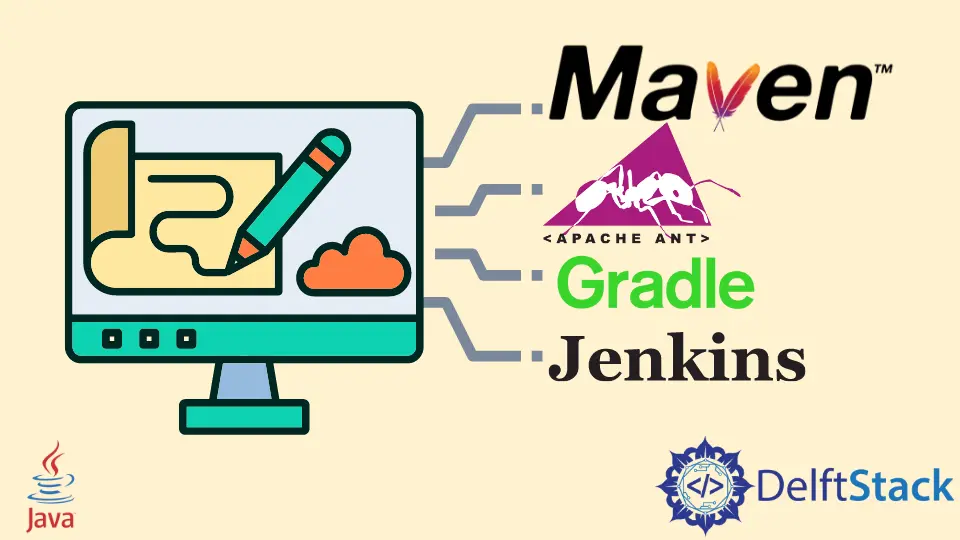How to Build Tools in Java

This article mainly focuses on Java build tools. First, we will learn what build tools are, and then we will discuss 5 of the most popular ones for Java.
What is Build Tools
Whatever programming language developers use to develop software, build tools play an important role in automating the build processes.
A build tool turns the software’s source code into executable code. We all know that whatever code we write in Java, the computer doesn’t understand.
So we must convert it into binary, which is what the build tool does.
Also, build tools, compile the code, run the test cases, and manage the software’s dependencies, packages, and deployment to the production system.
Furthermore, the question can arise: can’t we manage dependencies, packages, and compilation by ourselves? Yes, we can do that.
But think that we are making changes to our code 5 to 7 times per day if we follow the Agile development strategy. Will we waste our time compiling and downloading required dependencies whenever we update the version of our code?
Not really! We should use build tools to overcome these problems and save time.
Top 5 Build Tools in Java
Here, we have an overview of the top 5 Java build tools.
Gradle
A contemporary automation tool for project build automation is called Gradle.
It is used in software development. Gradle features a built-in DSL based on either Kotlin or Groovy code.
Gradle is a more up-to-date version of Apache Ant that uses Apache Groove, a domain-specific language (DSL), instead of XML. Every stage of the development of an app can benefit from using Gradle.
It allows incremental builds and can perform all of Ant’s functions, plus much more.
Ant and Maven are the foundations upon which Gradle is based. Gradle uses groovy scripts to declare the project configuration.
Gradle supports incremental builds by identifying which body components are the most recent because it was created for multi-project forms.
Maven
Since 2004 there has been this software program from the Apache Software Foundation. According to some, Maven is an updated version of Apache Ant.
This build tool is based on Java and supports projects written in other programming languages. It just requires that you create exceptions because it builds using conventions.
Maven makes it simple to create plugins for a particular purpose. Additionally, you can utilize it simultaneously for numerous projects. Maven is reliant on XML.
The Java development environment uses Apache Maven, a potent software project management tool, to manage, build, and maintain project dependencies. Maven uses XML to configure projects.
Ant
The predecessor of Apache Maven was Apache Ant. Ant was created as a substitute for the build tool Make, which was previously widely used in software development and was first made available in 2000.
Ant is used to automate build tasks using an XML file. Though, the Apache Ivy plugin is required for Ant to provide dependency management.
Learning Ant shouldn’t be too challenging if you are familiar with build tools, dependency management, and XML. It is still quite helpful even though it is regarded as “ancient”.
Apache Ant is incredibly adaptable. Depending on the functions you want this software to carry out, you can modify it.
For example, Apache Ant may be used to compile the source code of an app and run it, just like other build automation applications.
Jenkins
Java is the operating system for this free-build automation server. Many developers utilize Jenkins, which has been operating for more than ten years.
The 1,400 plugins increase the capabilities it can support. Jenkins can be used to compile, test, and deploy programs.
Jenkins can be started on a Java app server like Apache Tomcat as a standalone application or servlet.
It is often used as a tool for CD (Continuous Delivery) and CI (Continuous Integration). Jenkins is excellent for continuously developing and testing software projects.
Its features simplify the work of developers by enabling them to incorporate changes to a project and allow continuous software delivery by interacting with various testing and deployment tools.
SBT
This is a 2008 edition of an interaction build tool. The Scala Build Tool is called SBT.
It is regarded as one of the most widely used Java Build Tools. It supports Java even if Scala projects are its primary use.
In addition to offering all the capabilities in typical build automation software, SBT is explicitly tailored for Scala applications. It controls dependencies as well.
SBT has several plugins, and you can add further functionality to the program.
The SBT can carry out tasks in various JVM languages, including JavaScript and Ruby. One of the key advantages of utilizing SBT with Java projects is that it can set up a development environment and download dependencies automatically.
Other developers have created numerous plugins for SBT for Java.
Comparisons Between Java Build Tools
We’ve seen that some open sources and paid-for build automation solutions exist.
A Maven is a build tool, whereas Jenkins is a continuous integration tool if we compare the top tools, Jenkins and Maven. Jenkins can use Maven as a build tool.
Gradle is faster than Maven when the two are compared since it offers the characteristics of incrementality, build caching, and cradle daemon.
We can say that every tool is best in their way. But your decision will determine the build tool you choose for your Java projects.
